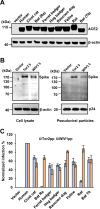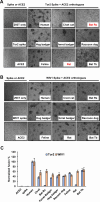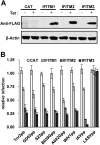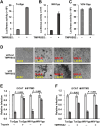Bat SARS-Like WIV1 coronavirus uses the ACE2 of multiple animal species as receptor and evades IFITM3 restriction via TMPRSS2 activation of membrane fusion
- PMID: 32602823
- PMCID: PMC7473123
- DOI: 10.1080/22221751.2020.1787797
Bat SARS-Like WIV1 coronavirus uses the ACE2 of multiple animal species as receptor and evades IFITM3 restriction via TMPRSS2 activation of membrane fusion
Abstract
Diverse SARS-like coronaviruses (SL-CoVs) have been identified from bats and other animal species. Like SARS-CoV, some bat SL-CoVs, such as WIV1, also use angiotensin converting enzyme 2 (ACE2) from human and bat as entry receptor. However, whether these viruses can also use the ACE2 of other animal species as their receptor remains to be determined. We report herein that WIV1 has a broader tropism to ACE2 orthologs than SARS-CoV isolate Tor2. Among the 9 ACE2 orthologs examined, human ACE2 exhibited the highest efficiency to mediate the infection of WIV1 pseudotyped virus. Our findings thus imply that WIV1 has the potential to infect a wide range of wild animals and may directly jump to humans. We also showed that cell entry of WIV1 could be restricted by interferon-induced transmembrane proteins (IFITMs). However, WIV1 could exploit the airway protease TMPRSS2 to partially evade the IFITM3 restriction. Interestingly, we also found that amphotericin B could enhance the infectious entry of SARS-CoVs and SL-CoVs by evading IFITM3-mediated restriction. Collectively, our findings further underscore the risk of exposure to animal SL-CoVs and highlight the vulnerability of patients who take amphotericin B to infection by SL-CoVs, including the most recently emerging (SARS-CoV-2).
Keywords: ACE2 receptor; IFITM; SARS-like coronavirus WIV1; TMPRSS2; viral entry.
Conflict of interest statement
No potential conflict of interest was reported by the author(s).
Figures






Similar articles
-
Isolation and characterization of a bat SARS-like coronavirus that uses the ACE2 receptor.Nature. 2013 Nov 28;503(7477):535-8. doi: 10.1038/nature12711. Epub 2013 Oct 30. Nature. 2013. PMID: 24172901 Free PMC article.
-
Difference in receptor usage between severe acute respiratory syndrome (SARS) coronavirus and SARS-like coronavirus of bat origin.J Virol. 2008 Feb;82(4):1899-907. doi: 10.1128/JVI.01085-07. Epub 2007 Dec 12. J Virol. 2008. PMID: 18077725 Free PMC article.
-
Structural determinants of spike infectivity in bat SARS-like coronaviruses RsSHC014 and WIV1.J Virol. 2024 Aug 20;98(8):e0034224. doi: 10.1128/jvi.00342-24. Epub 2024 Jul 19. J Virol. 2024. PMID: 39028202 Free PMC article.
-
Angiotensin-converting enzyme 2: The old door for new severe acute respiratory syndrome coronavirus 2 infection.Rev Med Virol. 2020 Sep;30(5):e2122. doi: 10.1002/rmv.2122. Epub 2020 Jun 30. Rev Med Virol. 2020. PMID: 32602627 Free PMC article. Review.
-
The pivotal link between ACE2 deficiency and SARS-CoV-2 infection.Eur J Intern Med. 2020 Jun;76:14-20. doi: 10.1016/j.ejim.2020.04.037. Epub 2020 Apr 20. Eur J Intern Med. 2020. PMID: 32336612 Free PMC article. Review.
Cited by
-
Syncytia formation by SARS-CoV-2-infected cells.EMBO J. 2020 Dec 1;39(23):e106267. doi: 10.15252/embj.2020106267. Epub 2020 Nov 4. EMBO J. 2020. PMID: 33051876 Free PMC article.
-
Decoding molecular factors shaping human angiotensin converting enzyme 2 receptor usage by spike glycoprotein in lineage B beta-coronaviruses.Biochim Biophys Acta Mol Basis Dis. 2022 Nov 1;1868(11):166514. doi: 10.1016/j.bbadis.2022.166514. Epub 2022 Aug 4. Biochim Biophys Acta Mol Basis Dis. 2022. PMID: 35932890 Free PMC article.
-
CRISPR-Cas9 genetic screens reveal regulation of TMPRSS2 by the Elongin BC-VHL complex.Sci Rep. 2025 Apr 7;15(1):11907. doi: 10.1038/s41598-025-95644-0. Sci Rep. 2025. PMID: 40195420 Free PMC article.
-
Protein S-palmitoylation in immunity.Open Biol. 2021 Mar;11(3):200411. doi: 10.1098/rsob.200411. Epub 2021 Mar 3. Open Biol. 2021. PMID: 33653086 Free PMC article. Review.
-
Evolution, Ecology, and Zoonotic Transmission of Betacoronaviruses: A Review.Front Vet Sci. 2021 May 20;8:644414. doi: 10.3389/fvets.2021.644414. eCollection 2021. Front Vet Sci. 2021. PMID: 34095271 Free PMC article. Review.
References
-
- WHO . Summary of probable SARS cases with onset of illness from November 1, 2002 to July 31, 2003 [cited 2004 Apr 21]; Available from: http://www.who.int/csr/sars/country/table2004_04_21/en/index.html). 2004.
-
- Li W, Shi Z, Yu M, et al. . Bats are natural reservoirs of SARS-like coronaviruses. Science. 2005 Oct 28;310(5748):676–679. - PubMed
MeSH terms
Substances
LinkOut - more resources
Full Text Sources
Miscellaneous
